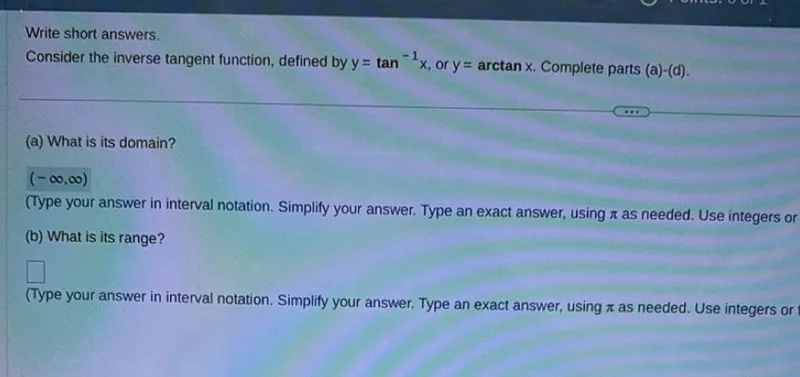(a) What is the domain of the inverse tangent function, defined by \( y=\tan ^{-1} x \), or \( y=\arctan x \)?
Understanding the inverse tangent function
The inverse tangent function \(\tan^{-1}x\) or \(\arctan x\) gives the angle whose tangent is x. To find its domain, we need to consider what values of x can be input into this function.
Analyzing the domain
Since the tangent function can take any real number as its range, the inverse tangent function can accept any real number as its input. There are no restrictions on the values of x that can be used in \(\tan^{-1}x\).
Expressing the domain in interval notation
Therefore, the domain of \(\tan^{-1}x\) is all real numbers, which we write in interval notation as \((-\infty, \infty)\).
\(\boxed{(-\infty, \infty)}\)
(b) What is the range of the inverse tangent function, defined by \( y=\tan ^{-1} x \), or \( y=\arctan x \)?
Understanding the range of inverse tangent
The range of \(\tan^{-1}x\) corresponds to the domain of the original tangent function. However, since tangent is periodic, we need to select a specific interval to make the inverse function well-defined.
Determining the principal range
The standard convention is to define the range of \(\tan^{-1}x\) as the interval \((-\frac{\pi}{2}, \frac{\pi}{2})\). This is because:
- The tangent function is one-to-one on this interval
- This interval covers exactly one period of the tangent function
- The tangent function takes all possible real values within this interval
Expressing the range in interval notation
Therefore, the range of \(\tan^{-1}x\) is \((-\frac{\pi}{2}, \frac{\pi}{2})\).
\(\boxed{(-\frac{\pi}{2}, \frac{\pi}{2})}\)
(a) Domain of \(\tan^{-1}x\): \(\boxed{(-\infty, \infty)}\)
(b) Range of \(\tan^{-1}x\): \(\boxed{(-\frac{\pi}{2}, \frac{\pi}{2})}\)






